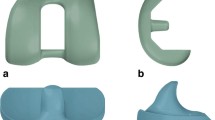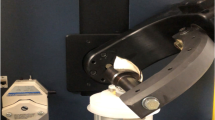Abstract
Background
Several studies have reported varus-valgus stability in the extension position after total knee arthroplasty (TKA). However, few studies have evaluated joint laxity in the flexion position postoperatively. The purpose of the study was to evaluate joint laxity against distal traction force on flexion after cruciate-retaining and posterior-stabilized total knee arthroplasties.
Methods
A total of 44 knees (22 knees cruciate-retaining, 22 knees posterior-stabilized) in 40 patients with osteoarthritis were tested in this study. The subjects were seated at a table and their knee joints were fixed at 80° of flexion to avoid overlapping images of condyles and the femoral shaft. Tibial shafts were adjusted to be parallel to the radiographic films, and posteroanterior radiographs were obtained. Flexion stress tests were performed with a distal traction of 100 N at a neutral foot position. Radiographs were obtained at neutral and traction positions. The distance from the perpendicular line of the top of the polyethylene insert to the midpoint on the tangential line of the femoral condyle was measured (joint space distance) at each side.
Results
In the flexion-neutral position, average joint space distances were 0.1 ± 0.2 mm in cruciate-retaining (CR) TKA knees and 0.2 ± 0.3 mm in posterior-stabilized (PS) TKA knees. With flexion-traction stress tests, the average joint space distances were 0.5 ± 0. 5 mm in CR TKA knees 2.4 ± 1.2 mm in PS TKA knees. Average changes of joint space distances between the two positions were 0.3 ± 0.4 mm (CR TKA) and 2.2 ± 1.5 mm (PS TKA). The changes in joint space distances between neutral and traction positions of PS TKA knees were significantly larger than those of CR TKA knees in flexion stress tests (P < 0.01).
Conclusion
The posterior cruciate ligament acted as a stabilizer against distal traction force in the CR-TKA knees. However, the laxity of PS-TKA knees against distal force differed among individual cases.
Similar content being viewed by others
References
Laskin RS. Flexion space configuration in total knee arthroplasty. J Arthroplasty 1995;10:657–660.
Griffin FM, Insall JN, Scuderi GR. Accuracy of soft tissue balancing in total knee arthroplasty. J Arthroplasty 2000;15:970–973.
Dennis DA, Komistek RD, Walker SA, Cheal EJ, Stiehl JB. Femoral condylar lift-off in vivo in total knee arthroplasty. J Bone Joint Surg Br 2001;83:33–39.
Stiehl JB, Dennis DA, Komistek RD, Crane HS. In vivo determination of condylar lift-off and screw-home in a mobile-bearing total knee arthroplasty. J Arthroplasty 1999;14:293–299.
Nilsson KG, Kärrholm J, Gadegaard P. Abnormal kinematics of the artificial knee: roentgen stereophotogrammetric analysis of 10 Miller-Galante and five New Jersey LCS knees. Acta Orthop Scand 1991;62:440–446.
Yagishita K, Muneta T, Ikeda H. Step-by-step measurements of soft tissue balancing during total knee arthroplasty for patients with varus knees. J Arthroplasty 2003;18:313–320.
Andriacchi TP, Galante JO, Fermier RW. The influence of total knee-replacement design on walking and stair-climbing. J Bone Joint Surg Am 1982;64:1328–1335.
Dorr LD, Ochsner JL, Gronley J, Perry J. Functional comparison of posterior cruciate retained versus cruciate-sacrificed total knee arthroplasty. Clin Orthop 1988;236:36–43.
Ishii Y, Terajima K, Koga Y, Takahashi HE, Bechtold JE, Gustilo RB. Gait analysis after total knee arthroplasty: comparison of posterior cruciate retention and substitution. J Orthop Sci 1998;3:310–317.
Draganich LF, Pottenger LA. The TRAC PS mobile-bearing prosthesis: design rationale and in vivo 3-dimensional laxity. J Arthroplasty 2000;15:102–111.
Stein A, Fleming B, Pope MH, Howe JG. Total knee arthroplasty kinematics: an in vivo evaluation of four different designs. J Arthroplasty 1988;3(suppl):S31–S36.
Matsuda S, Miura H, Nagamine R, Urabe K, Matsunobu T, Iwamoto Y. Knee stability in posterior cruciate ligament retaining total knee arthroplasty. Clin Orthop 1999;366:169–173.
Nabeyama R, Matsuda S, Miura H, Kawano T, Nagamine R, Mawatari T, et al. Changes in anteroposterior stability following total knee arthroplasty. J Orthop Sci 2003;8:526–531.
Louisia S, Siebold R, Canty J, Bartlett RJ. Assessment of posterior stability in total knee replacement by stress radiographs: prospective comparison of two different types of mobile bearing implants. Knee Surg Sports Traumatol Arthrosc 2005;13:476–482.
Matsuda Y, Ishii Y, Noguchi H, Ishii R. Varus-valgus balance and range of movement after total knee arthroplasty. J Bone Joint Surg Br 2005;87:804–808.
Matsuda Y, Ishii Y, Noguchi H, Ishii R. Effect of flexion angle on coronal laxity in patients with mobile-bearing total knee arthroplasty prostheses. J Orthop Sci 2005;10:37–41.
Yamakado K, Worland RL, Jessup DE, Diaz-Borjon E, Pinilla R. Tight posterior cruciate ligament in posterior cruciate-retaining total knee arthroplasty. J Arthroplasty 2003;18:570–574.
Galinat BJ, Vernace JV, Booth RE Jr, Rothman RH. Dislocation of the posterior stabilized total knee arthroplasty: a report of two cases. J Arthroplasty 1988;3:363–367.
Sharkey PF, Hozack WJ, Booth RE Jr, Balderston RA, Rothman RH. Posterior dislocation of total knee arthroplasty. Clin Orthop 1992;278:128–133.
Lombardi AV Jr, Mallory TH, Vaughn BK, Krugel R, Honkala TK, Sorscher M, et al. Dislocation following primary posteriorstabilized total knee arthroplasty. J Arthroplasty 1993;8:633–639.
Murase K, Kumano K, Mannouji T, Yokoe K, Kaneko K, Irie K, et al. Radiographical measurement of anteroposterior instability of the knee joint. Tokyo Hiza Kenkyukai-kaishi 1983;4:179–184 (in Japanese).
Bellemans J, Banks S, Victor J, Vandenneucker H, Moemans A. Fluoroscopic analysis of the kinematics of deep flexion in total nee arthroplasty. J Bone Joint Surg Br 2002;84:50–53.
Figgie HE 3rd, Goldberg VM, Heiple KG, Moller HS, Gordon NH. The influence of tibial-patellofemoral location on function of the knee in patients with the posterior stabilized condylar knee prosthesis. J Bone Joint Surg Am 1986;68:1035–1040.
Mihalko WM, Krackow KA. Posterior cruciate ligament effects on the flexion space in total knee arthroplasty. Clin Orthop 1999;360:243–250.
Cope MR, O’Brien BS, Nanu AM. The influence of the posterior cruciate ligament in the maintenance of joint line in primary total knee arthroplasty: a radiologic study. J Arthroplasty 2002;17:206–28.
Tanzer M, Smith K, Burnett S. Posterior-stabilized versus cruciate-retaining total knee arthroplasty: balancing the gap. J Arthroplasty 2002;17:813–819.
Kleinbart FA, Bryk E, Evangelista J, Scott WN, Vigorita V. Histologic comparison of posterior cruciate ligaments from arthritic and age-matched knee specimens. J Arthroplasty 1996;11:726–731.
Kadoya Y, Kobayashi A, Komatsu T, Nakagawa S, Yamano Y. Effects of posterior cruciate ligament resection on the tibiofemoral joint gap. Clin Orthop 2001;391:210–217.
Author information
Authors and Affiliations
About this article
Cite this article
Tsuneizumi, Y., Suzuki, M., Miyagi, J. et al. Evaluation of joint laxity against distal traction force upon flexion in cruciate-retaining and posterior-stabilized total knee arthroplasty. J Orthop Sci 13, 504–509 (2008). https://doi.org/10.1007/s00776-008-1269-8
Received:
Accepted:
Published:
Issue Date:
DOI: https://doi.org/10.1007/s00776-008-1269-8




